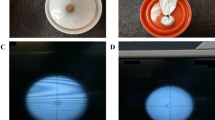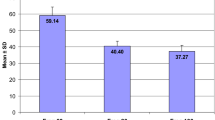Abstract
Extracorporeal shock wave lithotripsy has recently been introduced as the first non-operative treatment alternative for patients with sialolithiasis. Using conventional multipurpose lithotripters, however, successful treatment was achieved in only 36%–53% of patients. Therefore we developed an miniaturized lithotripter meeting the special requirements for extracorporeal shock wave treatment in the head and neck region. During a 1-year prospective trial clinical efficacy and safety were compared in 40 patients treated with a conventional electromagnetic lithotripter (group A) to 33 patients treated with the newly developed, miniaturized device (group B). The groups did not differ statistically regarding stone size or number or the proportion of stones located in the submandibular or parotid gland. Successful stone targeting, a prerequisite for shock wave treatment, was achieved by means of in-line ultrasonography in 30 of the 40 patients in group A and in 29 of 33 patients of group B. The number of shock wave impulses administered per session and the maximum shock wave intensities did not differ in the two groups. Significantly more frequent treatments with a longer mean duration of each session were required in group A (2.4 ± 1.0 treatments, 47 ± 11 min) than in group B (1.9 ± 0.7 treatments, 28 ± 9 min; P < 0.05). After a 3 month follow-up significantly more patients were free of stones in group B (22/33) than in group A (16/40; P < 0.05). Correspondingly, the number of patients free of complaints was significantly higher in group B (27/33) than in group A (22/40; P < 0.05). Side effects did not differ between the two types of lithotripters, and they were moderate in intensity, completely reversible, and therefore without influence on the patient's outcome. It is concluded that the new miniaturized lithotripter provides a substantial progress for the feasibility and efficacy of shock wave treatment in sialolithiasis.
Similar content being viewed by others
References
Chaussy C, Brendel W, Schmiedt E (1980) Extracorporeally induced destruction of kidney stones by shock waves. Lancet I:1265–1268
Ell C, Kerzel W, Schneider HT, Benninger J, Wirtz P, Domschke W, Hahn EG (1990) Piezoelectric lithotripsy: stone disintegration and follow-up results in patients with symptomatic gallbladder stones. Gastroenterology 99:1439–1444
Hessling KH, Schlick RW, Luckey R, Gratz K, Qaiyumi AA, Allhoff EP (1993) Die therapeutische Wertigkeit der ambulanten extrakorporalen Stoβwellenlithotripsie von Speichelsteinen. Ergebnisse einer prospektiven Studie. Laryngorhinootol 72:109–115
Iro H, Nitsche N, Schneider T, Ell C (1989) Extracorporeal shockwave lithotripsy of salivary gland stones. Lancet II:115
Iro H, Wessel B, Benzel W, Meier J, Nitsche N, Zenk J, Wirtz P, Ell C (1990) Gewebereaktionen unter Applikation von piezoelektrischen Stosswellen zur Lithotripsie von Speichelsteinen. Laryngorhinootol 69:102–107
Iro H, Schneider HT, Födra C, Waitz P, Nitsche N, Heinritz HH, Benninger J, Ell C (1992) Shockwave lithotripsy of salivary duct stones. Lancet 339:1333–36
Kater W, Meyer WW, Wehrmann T, Hurst A, Liermann D, Peters J, Rahn R, Desloovere C (1991) Die Lithotripsie von Speichelsteinen als nichtinvasive Behandlungsalternative. Dtsch Ärztebl 88:2163–2166
Sackmann M, Delius M, Sauerbruch T, Holl J, Weber W, Ippisch E, Hagelauer U, Wess O, Hepp W, Brendel W, Paumgartner G (1988) Shock-wave lithotripsy of gallbladder stones — the first 175 patients. N Engl J Med 318:393–397
Seifert G, Miehlke A, Haubrich J, Chilla R (1986) Diseases of the salivary glands. Thieme, Stuttgart, pp 91–97
Wehrmann T, Hurst A, Jung M, Lembcke B, Caspary WF (1993) Biliary lithotripsy with a new electromagnetic shock wave source. Dig Dis Sci 38:2113–2120
Author information
Authors and Affiliations
Rights and permissions
About this article
Cite this article
Wehrmann, T., Kater, W., Marlinghaus, E.H. et al. Shock wave treatment of salivary duct stones substantial progress with a minilithotripter. Clin Investig 72, 604–608 (1994). https://doi.org/10.1007/BF00227453
Received:
Accepted:
Issue Date:
DOI: https://doi.org/10.1007/BF00227453




